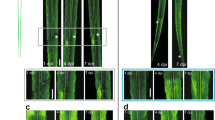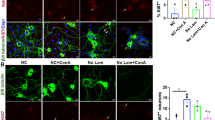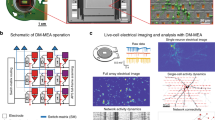Abstract
An understanding of the molecular mechanisms of axon regeneration after injury is key for the development of potential therapies. Single-cell axotomy of dissociated neurons enables the study of the intrinsic regenerative capacities of injured axons. This protocol describes how to perform single-cell axotomy on dissociated hippocampal neurons containing synapses. Furthermore, to axotomize hippocampal neurons integrated in neuronal circuits, we describe how to set up coculture with a few fluorescently labeled neurons. This approach allows axotomy of single cells in a complex neuronal network and the observation of morphological and molecular changes during axon regeneration. Thus, single-cell axotomy of mature neurons is a valuable tool for gaining insights into cell intrinsic axon regeneration and the plasticity of neuronal polarity of mature neurons. Dissociation of the hippocampus and plating of hippocampal neurons takes ∼2 h. Neurons are then left to grow for 2 weeks, during which time they integrate into neuronal circuits. Subsequent axotomy takes 10 min per neuron and further imaging takes 10 min per neuron.
This is a preview of subscription content, access via your institution
Access options
Subscribe to this journal
Receive 12 print issues and online access
$259.00 per year
only $21.58 per issue
Buy this article
- Purchase on Springer Link
- Instant access to full article PDF
Prices may be subject to local taxes which are calculated during checkout






Similar content being viewed by others
References
Bradke, F., Fawcett, J.W. & Spira, M.E. Assembly of a new growth cone after axotomy: the precursor to axon regeneration. Nat. Rev. Neurosci. 13, 183–193 (2012).
Cafferty, W.B.J., McGee, A.W. & Strittmatter, S.M. Axonal growth therapeutics: regeneration or sprouting or plasticity? Trends Neurosci. 31, 215–220 (2008).
Kwon, B.K., Oxland, T.R. & Tetzlaff, W. Animal models used in spinal cord regeneration research. Spine 27, 1504–1510 (2002).
Rosenzweig, E.S. & McDonald, J.W. Rodent models for treatment of spinal cord injury: research trends and progress toward useful repair. Curr. Opin. Neurol. 17, 121–131 (2004).
Tuszynski, M.H.M. & Steward, O.O. Concepts and methods for the study of axonal regeneration in the CNS. Neuron 74, 777–791 (2012).
Hellal, F. et al. Microtubule stabilization reduces scarring and causes axon regeneration after spinal cord injury. Science 331, 928–931 (2011).
Dimou, L. et al. Nogo-A–deficient mice reveal strain-dependent differences in axonal regeneration. J. Neurosci. 26, 5591–5603 (2006).
Misgeld, T., Nikic, I. & Kerschensteiner, M. In vivo imaging of single axons in the mouse spinal cord. Nat. Protoc. 2, 263–268 (2007).
Ertürk, A., Hellal, F., Enes, J. & Bradke, F. Disorganized microtubules underlie the formation of retraction bulbs and the failure of axonal regeneration. J. Neurosci. 27, 9169–9180 (2007).
Laskowski, C.J. & Bradke, F. In vivo imaging: a dynamic imaging approach to study spinal cord regeneration. Exp. Neurol. 242, 11–17 (2013).
Silver, J. & Miller, J.H. Regeneration beyond the glial scar. Nat. Rev. Neurosci. 5, 146–156 (2004).
Ylera, B. et al. Chronically CNS-injured adult sensory neurons gain regenerative competence upon a lesion of their peripheral axon. Curr. Biol. 19, 930–936 (2009).
Chuckowree, J.A. & Vickers, J.C. Cytoskeletal and morphological alterations underlying axonal sprouting after localized transection of cortical neuron axons in vitro. J. Neurosci. 23, 3715–3725 (2003).
Chung, R.S. et al. Mild axonal stretch injury in vitro induces a progressive series of neurofilament alterations ultimately leading to delayed axotomy. J. Neurotrauma 22, 1081–1091 (2005).
Smith, D.H., Wolf, J.A., Lusardi, T.A., Lee, V.M. & Meaney, D.F. High tolerance and delayed elastic response of cultured axons to dynamic stretch injury. J. Neurosci. 19, 4263–4269 (1999).
Gomis-Rüth, S., Wierenga, C.J. & Bradke, F. Plasticity of polarization: changing dendrites into axons in neurons integrated in neuronal circuits. Curr. Biol. 18, 992–1000 (2008).
Dotti, C.G.C. & Banker, G.A.G. Experimentally induced alteration in the polarity of developing neurons. Nature 330, 254–256 (1987).
Bradke, F. & Dotti, C.G. Differentiated neurons retain the capacity to generate axons from dendrites. Curr. Biol. 10, 1467–1470 (2000).
Goslin, K.K. & Banker, G.G. Experimental observations on the development of polarity by hippocampal neurons in culture. J. Cell Biol. 108, 1507–1516 (1989).
Stiess, M. & Bradke, F. Neuronal polarization: the cytoskeleton leads the way. Dev Neurobiol 71, 430–444 (2011).
Takahashi, D., Yu, W., Baas, P.W., Kawai-Hirai, R. & Hayashi, K. Rearrangement of microtubule polarity orientation during conversion of dendrites to axons in cultured pyramidal neurons. Cell Motil. Cytoskeleton 64, 347–359 (2007).
Calderon de Anda, F., Gartner, A., Tsai, L.H. & Dotti, C.G. Pyramidal neuron polarity axis is defined at the bipolar stage. J. Cell Sci. 121, 178–185 (2008).
Ohara, R. et al. Axotomy induces axonogenesis in hippocampal neurons by a mechanism dependent on importin β. Biochem. Biophys. Res. Commun. 405, 697–702 (2011).
Cho, Y. & Cavalli, V. HDAC5 is a novel injury-regulated tubulin deacetylase controlling axon regeneration. EMBO J. 31, 3063–3078 (2012).
Stiess, M. et al. Axon extension occurs independently of centrosomal microtubule nucleation. Science 327, 704–707 (2010).
Busch, S.A., Horn, K.P., Silver, D.J. & Silver, J. Overcoming macrophage-mediated axonal dieback following CNS injury. J. Neurosci. 29, 9967–9976 (2009).
Verma, P. et al. Axonal protein synthesis and degradation are necessary for efficient growth cone regeneration. J. Neurosci. 25, 331–342 (2005).
Vogelaar, C.F. et al. Axonal mRNAs: characterisation and role in the growth and regeneration of dorsal root ganglion axons and growth cones. Mol. Cell. Neurosci. 42, 102–115 (2009).
Rasband, M.N.M. The axon initial segment and the maintenance of neuronal polarity. Nat. Rev. Neurosci. 11, 552–562 (2010).
Kaech, S. & Banker, G. Culturing hippocampal neurons. Nat. Protoc. 1, 2406–2415 (2007).
Bradke, F. & Dotti, C.G. Neuronal polarity: vectorial cytoplasmic flow precedes axon formation. Neuron 19, 1175–1186 (1997).
Okabe, M.M., Ikawa, M.M., Kominami, K.K., Nakanishi, T.T. & Nishimune, Y.Y. 'Green mice' as a source of ubiquitous green cells. FEBS Lett. 407, 7–7 (1997).
Flynn, K.C. et al. ADF/Cofilin-mediated actin retrograde flow directs neurite formation in the developing brain. Neuron 76, 1091–1107 (2012).
Garvalov, B.K. et al. Cdc42 regulates cofilin during the establishment of neuronal polarity. J. Neurosci. 27, 13117–13129 (2007).
Nikonenko, I., Boda, B., Alberi, S. & Muller, D. Application of photoconversion technique for correlated confocal and ultrastructural studies in organotypic slice cultures. Microsc. Res. Tech. 68, 90–96 (2005).
Grabenbauer, M. et al. Correlative microscopy and electron tomography of GFP through photooxidation. Nat. Methods 2, 857–862 (2005).
Knott, G.W., Holtmaat, A., Trachtenberg, J.T., Svoboda, K. & Welker, E. A protocol for preparing GFP-labeled neurons previously imaged in vivo and in slice preparations for light and electron microscopic analysis. Nat. Protoc. 4, 1145–1156 (2009).
Acknowledgements
We thank B. Garvalov and K. Flynn for their suggestions and revisions to this manuscript. F.B. was supported by Wings for Life (WfL), the International Foundation for Research in Paraplegia (IRP) and the Deutsche Forschungsgemeinschaft (DFG). S.G.-R. was supported by a grant from Boehringer Ingelheim Fonds. M.S. was supported by a European Molecular Biology Organization (EMBO) long-term fellowship and is supported by the Human Frontier Science Program.
Author information
Authors and Affiliations
Contributions
S.G.-R., L.M. and F.B. conceived and designed the protocol and experimental procedures. S.G.-R., M.S., L.M. and C.J.W. performed cultures and experiments. S.G.-R., M.S. and F.B. wrote the manuscript. F.B. supervised the project.
Corresponding author
Ethics declarations
Competing interests
The authors declare no competing financial interests.
Rights and permissions
About this article
Cite this article
Gomis-Rüth, S., Stiess, M., Wierenga, C. et al. Single-cell axotomy of cultured hippocampal neurons integrated in neuronal circuits. Nat Protoc 9, 1028–1037 (2014). https://doi.org/10.1038/nprot.2014.069
Published:
Issue Date:
DOI: https://doi.org/10.1038/nprot.2014.069
This article is cited by
Comments
By submitting a comment you agree to abide by our Terms and Community Guidelines. If you find something abusive or that does not comply with our terms or guidelines please flag it as inappropriate.



